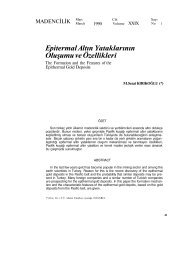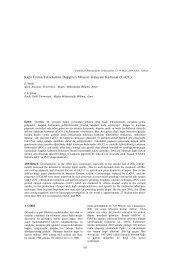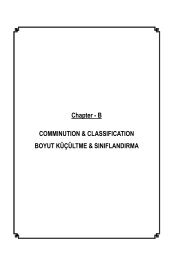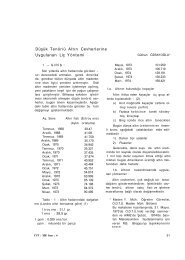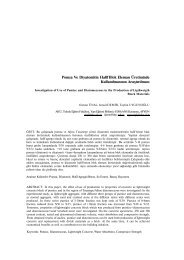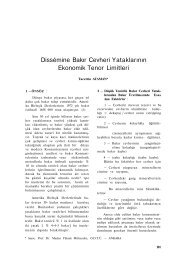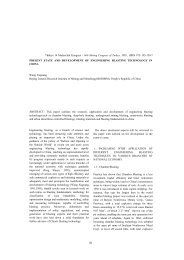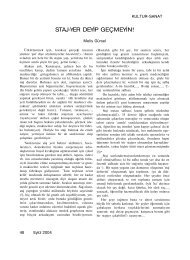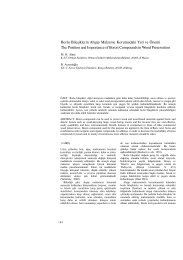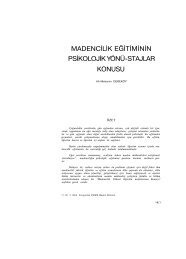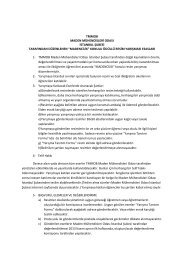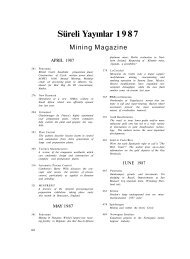A OPEN PIT MINING AÇIK OCAK MADENCİLİĞİ
A OPEN PIT MINING AÇIK OCAK MADENCİLİĞİ
A OPEN PIT MINING AÇIK OCAK MADENCİLİĞİ
Create successful ePaper yourself
Turn your PDF publications into a flip-book with our unique Google optimized e-Paper software.
23 rd <br />
Efficient Real Time Stability Monitoring of Mine Walls: The<br />
Çöllolar Mine Case Study<br />
P. Farina, N. Coli<br />
IDS, Ingegneria dei Sistemi SpA, Pisa, Italy<br />
R.Yön, G. Eken, H. Ketizmen<br />
Ciner Group, Turkey<br />
ABSTRACT Slope monitoring radar has emerged in the last ten years as a leading edge tool<br />
for monitoring movements in open pit mines, thanks to the ability to rapidly measure wall<br />
movements with millimetric accuracy over wide areas in any weather conditions. IBIS-M is<br />
an innovative interferometric radar able to provide high spatial resolution, long working<br />
distances and fast acquisition time. The first IBIS-M unit deployed in Turkey was installed in<br />
2011 at the large lignite open pit Çöllolar Mine operated by Park Teknik. The geotechnical<br />
staff has now 24/7 real time monitoring of the slope stability with a wide coverage on the pit<br />
walls with the capability to detect the onset of wall movements far before the occurrence of<br />
failure, thus increasing the safety standards and productivity of the mine. The IBIS-M<br />
monitoring experience at Çöllolar mine is presented in this paper.<br />
1 INTRODUCTION<br />
In surface mining industry a comprehensive<br />
slope monitoring program, aimed at<br />
managing potential large-scale instabilities<br />
and able to detect at the same time local<br />
scale movements, should represent an<br />
integral part of every effective slope<br />
management system. Among all the<br />
parameters to be considered and included in<br />
an effective slope monitoring program<br />
displacements, either surface or sub-surface<br />
components, play a crucial role. In fact, in<br />
open pit mines large failures are usually<br />
preceded by small scale slope movements,<br />
sometimes limited to few centimeters of total<br />
displacement and typically characterized by<br />
temporal evolutions ranging from several<br />
hours to several weeks.<br />
The capability of providing advanced<br />
notice over the whole slope of impending<br />
instability conditions, through the accurate<br />
and timely measurement of precursor to<br />
slope collapses clearly represents an<br />
outstanding benefit for the staff of the pit<br />
involved in the geotechnical risk<br />
management.<br />
The use of slope monitoring radars in<br />
open pit mines is today a standard practice<br />
for active monitoring of the pit walls. Radar<br />
units are effectively used to get a better<br />
understanding of the spatial distribution of<br />
slope movements and for the provision of<br />
alerts in the event of progressive movements<br />
that can potentially lead to slope failure, thus<br />
aimed at assessing the safety of workers and<br />
increase the mine productivity.<br />
Radar technology presents the advantages<br />
of high accuracy of the measurements, longrange<br />
capabilities, limited impact of<br />
atmospheric artifacts on the measurement<br />
performances, and possibility to<br />
simultaneously acquire the response over a<br />
large number of points without the need to<br />
install artificial reflectors on the slope.<br />
Slope monitoring radars are based on the<br />
radar interferometry, a well-known<br />
technology originally developed for satellite<br />
applications in order to retrieve ground<br />
111



